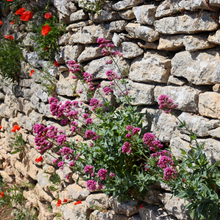Centranthus ruber 'Coccineus', commonly known as red valerian, is a sturdy perennial noted for its deep red flower clusters and adaptable nature. This plant displays fleshy, grey-green leaves and produces branching stems that bear numerous small, fragrant flowers from late spring into autumn. Its extended blooming period and ability to thrive in less fertile soils make it a valuable addition to gardens, borders, and walls, adding a bold splash of color to various settings. It is part of the Caprifoliaceae family.
Origin: Centranthus ruber is native to the Mediterranean region. The 'Coccineus' cultivar was selected for its deep red flower colour.
Light: Centranthus ruber 'Coccineus' flourishes in full sunlight. It requires at least six hours of direct sunlight each day for optimal flowering and growth.
Water: Water regularly during the first growing season to assist in establishing a strong root system. Once established, it demonstrates some tolerance to drier conditions. Allow the soil to dry slightly between waterings to prevent root rot.
Soil: Centranthus ruber 'Coccineus' prefers soil that drains well. It can adapt to a range of soil types, including less fertile, rocky, and alkaline soils. Avoid heavy clay soils, which retain excessive moisture.
Fertilising: This plant generally does not require heavy feeding. A light application of a balanced fertiliser in spring can promote healthy growth. Avoid over-fertilising, which can lead to excessive leaf growth at the expense of flower production.
Pruning: Removing spent flowers can extend the blooming period. Cut back the plant in late autumn or early spring to tidy it up and encourage new growth.
Self-seeding: Centranthus ruber 'Coccineus' readily self-seeds, so new plants may appear in the garden.
Pests and Diseases: Centranthus ruber 'Coccineus' is generally resistant to pests and diseases.
Uses: Centranthus ruber 'Coccineus' is primarily cultivated for its attractive flowers and extended blooming period. It is a popular choice for gardens, borders, walls, and coastal gardens. It also attracts bees and butterflies.
Toxicity: Centranthus ruber 'Coccineus' is generally considered safe for humans and pets.



